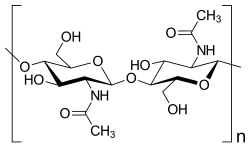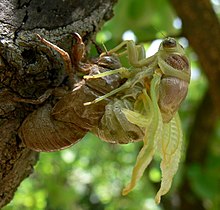
Back كايتين Arabic Quitina AST Xitin Azerbaijani Хитин Bashkir Хіцін Byelorussian Хітын BE-X-OLD Хитин Bulgarian কাইটিন Bengali/Bangla Hitin BS Quitina Catalan




Chitin (C8H13O5N)n (/ˈkaɪtɪn/ KY-tin) is a long-chain polymer of N-acetylglucosamine, an amide derivative of glucose. Chitin is the second most abundant polysaccharide in nature (behind only cellulose); an estimated 1 billion tons of chitin are produced each year in the biosphere.[1] It is a primary component of cell walls in fungi (especially filamentous and mushroom-forming fungi), the exoskeletons of arthropods such as crustaceans and insects, the radulae, cephalopod beaks and gladii of molluscs and in some nematodes and diatoms.[2][3] It is also synthesised by at least some fish and lissamphibians.[4] Commercially, chitin is extracted from the shells of crabs, shrimps, shellfish and lobsters, which are major by-products of the seafood industry.[2][3] The structure of chitin is comparable to cellulose, forming crystalline nanofibrils or whiskers. It is functionally comparable to the protein keratin. Chitin has proved useful for several medicinal, industrial and biotechnological purposes.[3][5]
- ^ Nelson, D.L., Cox, M.M. (2017). Lehninger Principles of Biochemistry (7th ed.). McMillan Learning. ISBN 978-1-4641-2611-6.
{{cite book}}: CS1 maint: multiple names: authors list (link) - ^ a b Sanjanwala, Dhruv; Londhe, Vaishali; Trivedi, Rashmi; Bonde, Smita; Sawarkar, Sujata; Kale, Vinita; Patravale, Vandana (2022-12-02). "Polysaccharide-based hydrogels for drug delivery and wound management: a review". Expert Opinion on Drug Delivery. 19 (12): 1664–1695. doi:10.1080/17425247.2022.2152791. ISSN 1742-5247. PMID 36440488. S2CID 254041961.
- ^ a b c Sanjanwala, Dhruv; Londhe, Vaishali; Trivedi, Rashmi; Bonde, Smita; Sawarkar, Sujata; Kale, Vinita; Patravale, Vandana (2024-01-01). "Polysaccharide-based hydrogels for medical devices, implants and tissue engineering: A review". International Journal of Biological Macromolecules. 256 (Pt 2): 128488. doi:10.1016/j.ijbiomac.2023.128488. ISSN 0141-8130. PMID 38043653.
- ^ Tang, WJ; Fernandez, JG; Sohn, JJ; Amemiya, CT (2015). "Chitin is endogenously produced in vertebrates". Curr Biol. 25 (7): 897–900. Bibcode:2015CBio...25..897T. doi:10.1016/j.cub.2015.01.058. PMC 4382437. PMID 25772447.
- ^ Morin-Crini, Nadia; Lichtfouse, Eric; Torri, Giangiacomo; Crini, Grégorio (2019-12-01). "Applications of chitosan in food, pharmaceuticals, medicine, cosmetics, agriculture, textiles, pulp and paper, biotechnology, and environmental chemistry". Environmental Chemistry Letters. 17 (4): 1667–1692. Bibcode:2019EnvCL..17.1667M. doi:10.1007/s10311-019-00904-x. ISSN 1610-3661.